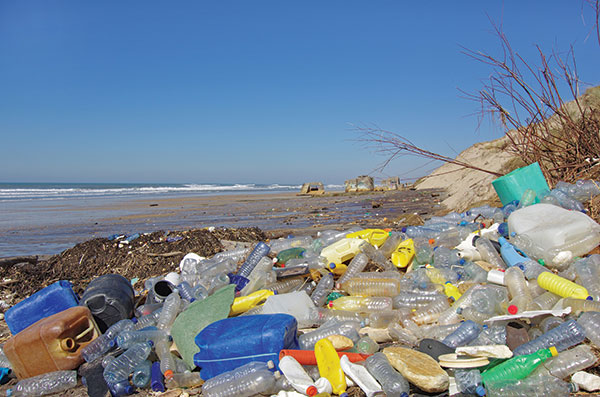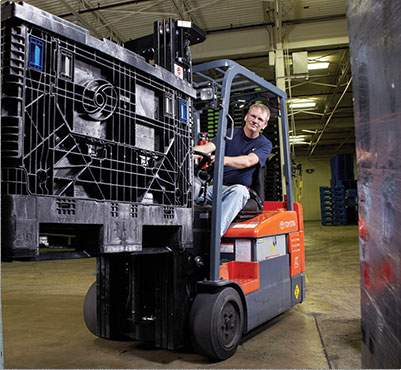Recycling coastline plastic into premium reusable packaging
Plastic waste on the beach is now being used in packaging from totes to bulk containers. And if one pioneer has her way, this is only a start.

Sometimes exact number is not as important as relative size. Consider the amount of plastic that finds its way into oceans and other waterways every year. The generally accepted range is 8 to 12 million metric tons annually. Quite a range, but, importantly, a lot more than any of us can visually imagine. Experts estimate that 60% to 90% of all ocean debris is single-use plastic.
The problem is larger than that. There’s the matter of plastic waste that is still on land, but on its way to the water. Known as coastline waste in polite circles, it’s what we all find during a walk along the beach.
 But something can be done about it, fortunately. Just ask Breanna Herbert, associate product manager and sustainability lead at plastic packaging supplier ORBIS Corp.
But something can be done about it, fortunately. Just ask Breanna Herbert, associate product manager and sustainability lead at plastic packaging supplier ORBIS Corp.
As Herbert explains, the company is using 25% coastline waste in a range of products from totes to bulk containers. “We have a great sense of pride at ORBIS that we are recycling into premium reusable plastic packaging what otherwise would be floating around in the ocean. That’s important on a couple of fronts. One, it makes people feel good. But, this also reduces the amount of new, virgin plastic consumed in our products,” says Herbert.
Interestingly, using coastline waste is not a cost saver for ORBIS. There is a premium when compared to virgin plastic resin. And, there’s a lot involved to get the recycled waste to the molding machines to make the packaging. So, coastline waste is not a politically correct shortcut.
 Herbert says ORBIS sources waste from Haiti, the Philippines and Egypt. Local collectors sell their harvest to local recyclers. They sort it by density to ensure that the high-density polyethylene, for instance, goes in the high-density polyethylene pile. Then it gets shredded, tested for consistency and sold. Before ORBIS uses the plastic, it does its own testing to ensure quality, says Herbert. Recovered plastic coastline waste is carefully blended with virgin resin to ensure the performance specs of the packaging meet established ORBIS standards.
Herbert says ORBIS sources waste from Haiti, the Philippines and Egypt. Local collectors sell their harvest to local recyclers. They sort it by density to ensure that the high-density polyethylene, for instance, goes in the high-density polyethylene pile. Then it gets shredded, tested for consistency and sold. Before ORBIS uses the plastic, it does its own testing to ensure quality, says Herbert. Recovered plastic coastline waste is carefully blended with virgin resin to ensure the performance specs of the packaging meet established ORBIS standards.
Neither Herbert nor ORBIS came up with the idea. One of ORBIS’ customers, a major office furniture manufacturer did. They were already using coastline waste for some injection molded parts in their chairs. Today, this company uses totes and other containers with waste material from ORBIS. While it may not have been Herbert’s idea, she does feel like a pioneer. She estimates as much as 5% of all plastic consumed by ORBIS could be recovered coastline waste in just a couple of years.
“Single-use plastic has a bad reputation, especially with all the mis-managed waste. However, innovative material streams like this one show there’s hope for the future. We’ve got to start somewhere,” says Herbert.

Article Topics
Blogs News & Resources
Two voices of reason on pallet materials 60 Seconds with Bob Trebilcock, outgoing executive editor, Modern Materials Handling Learn from lift truck service history The reBound Podcast: How Pitney-Bowes is innovating with autonomous vehicles. Packaging Corner: Be open to change 60 Seconds with Robert Martichenko of American Logistics Aid Network The reBound Podcast: Looking for talent in all the right places: How Essendant is revolutionizing recruitment More BlogsLatest in Materials Handling
Beckhoff USA opens new office in Austin, Texas Manhattan Associates selects TeamViewer as partner for warehouse vision picking ASME Foundation wins grant for technical workforce development The (Not So) Secret Weapons: How Key Cabinets and Asset Management Lockers Are Changing Supply Chain Operations MODEX C-Suite Interview with Harold Vanasse: The perfect blend of automation and sustainability Consultant and industry leader John M. Hill passes on at age 86 Registration open for Pack Expo International 2024 More Materials HandlingSubscribe to Materials Handling Magazine

Find out what the world's most innovative companies are doing to improve productivity in their plants and distribution centers.
Start your FREE subscription today.
April 2024 Modern Materials Handling

Latest Resources










